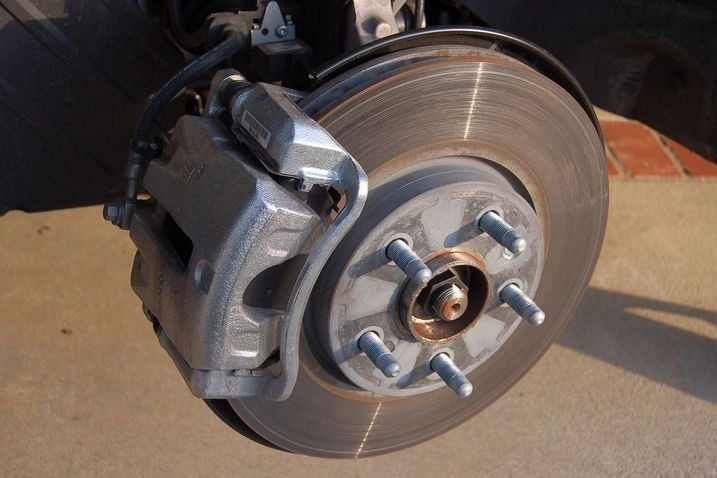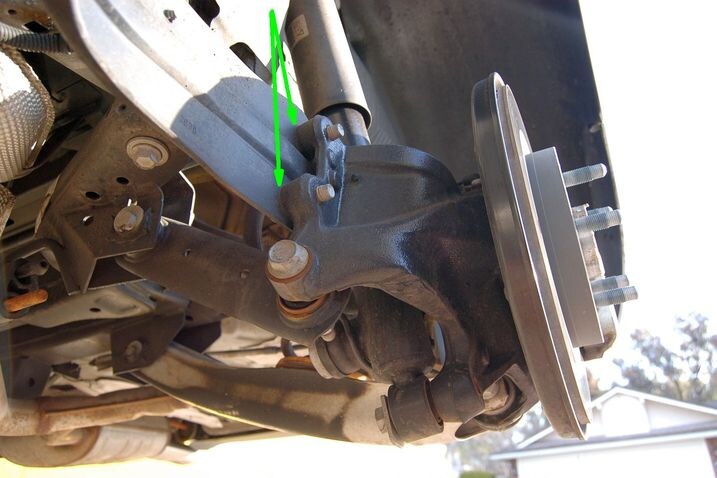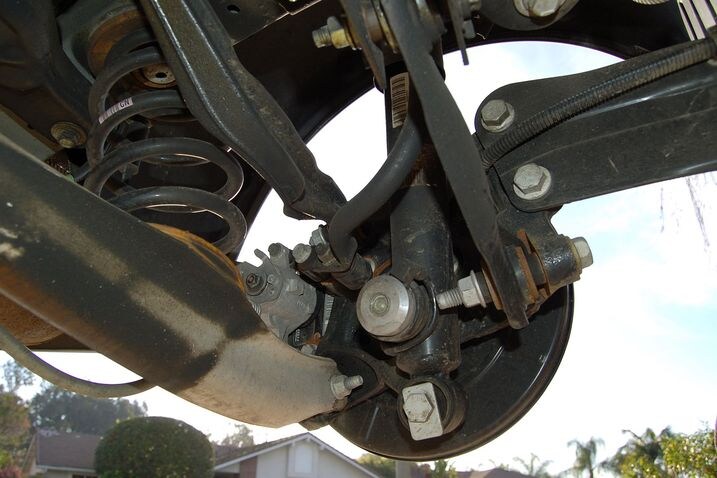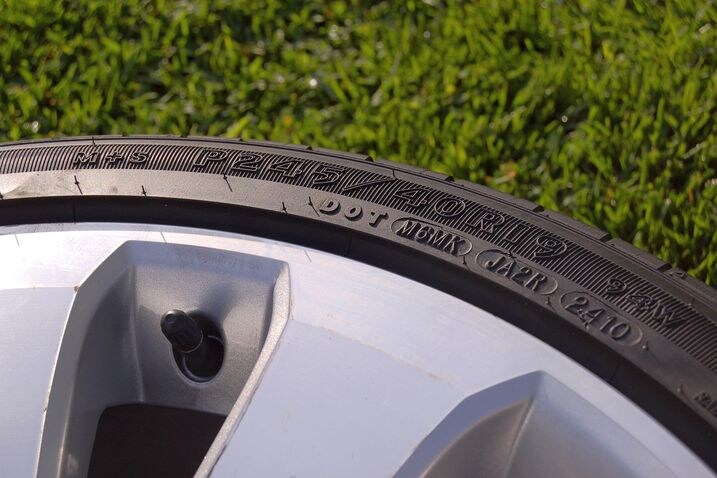
We've recently seen the underbelly of the 2011 Buick LaCrosse CXS and its unique Hiper Strut front suspension. Now it's time to have a look at its little brother, the 2011 Buick Regal CXL Turbo.
Why? Couple reasons. First, it's a long-term car, and I try to give all of our LT cars equal time on the jack stands.
Second, the Regal lineup currently offers no version with Hiper Strut, but it will next year. A new 2012 Buick Regal GS is coming, with a revised 2.0T engine that makes at least 35 more horsepower (possibly as much as 50 hp more) and 37 additional lb-ft of torque. A 6-speed manual transmission will be the standard offering, with a 6-speed autobox available as an option.
All of this is fantastic, but both developments increase the likelihood of torque steer. Also, a hot-rod model needs great steering. And so Hiper strut will appear on the Regal next year, but only on the fortified GS version.
With that in mind, lets look at our current Regal CXL Turbo, the one that feeds "only" 220 horsepower and 258 lb-ft of torque to its front wheels. I'll point out the 2012 Regal GS differences I know of as we go along. And, if you haven't already, make sure to click on the LaCrosse walkaround link to see what Hiper Strut is all about.

The front end of our Regal CXL Turbo rides on standard strut suspension of the non-Hiper variety.

All standard struts turn left and right because they are firmly firmly bolted to the knuckle/upright at point yellow. The upper pivot of this assembly is therefore high up in the fender, resulting in a kingpin axis that is less than optimal.
Pay no attention to the proximity of the yellow arrow and the green line. Do pay attention to the little black cube just above the arrowhead -- it'll mean something a bit later.

As expected, the Regal has a direct-acting stabilizer bar link (green) and rear-acting steering (yellow).
The steering here is hydraulic, which is good, but it tuned with tons of Buick lightness and has far too little feel. Hiper Strut helped the LaCrosse develop good feel without being overly heavy from a Buick customer standpoint.
Hopefully the sporty nature of the 2012 Buick GS will allow GM engineers to take even greater advantage of Hiper Strut when they tune that car's steering.

Aluminum knuckle? Check. Aluminum lower control arm? Check.

The Regal's L-shaped lower control arm converts the fore-aft component of road impacts into an in-out motion at the rear pivot bushing.

...which explains the offset mounting of the bush and directional shape of the bushing inside this housing, as indicated by the presence of these two extra rubber bumpers.

In this cases CDC does not stand for the Center for Disease Control. Instead it means Computer Damping Control, the name given to it by Sachs, the supplier that makes theses adjustable dampers for GM and others.
General Motors sometimes describes the feature as "Continuously Variable Real-Time Damping". It's standard today on the 2011 Buick Regal Turbo and it will return again in the 2012 Regal Turbo. No word if the 2012 GS will get unique software tuning, but it's likely.

The green arrow indicates the CDC actuator, a computer-controlled bypass valve that adjusts the level of damping. More bypass = softer, less bypass = stiffer. Because this valve is externally mounted, Sachs calls this a CDCe strut.
This is also the part where you should remember that little black cube we saw a few shots back. That was the wheel accelerometer, and each of the four wheels has one. A fifth body accelerometer is buried somewhere inside the car, mostly likely in the middle near the center of mass. The CDC electronics control unit compares each of the wheel accelerometers to the body accelerometer in order to decide what to do at any given instant.

In addition to the Hi-Po engine and the Hiper Strut suspension, the 2012 Buick Regal GS will also have Brembo fixed caliper front brakes instead of these single-piston sliding calipers. No word on the number of pistons next year, but I think four should be enough. I'm also going to go out on a limb and predict they'll be red.

In back, our 2011 Buick Regal looks much the same as the 20011 Buick Lacrosse we saw a couple of weeks ago. It's the same suspension type, and I'm pretty sure a lot of the pieces are interchangeable.
The Regal's track is listed 0.7 inches wider in front and 0.5 inches wider in the rear compared to a LaCrosse, small enough to be put down to wheel offset or alignment differences.
For our purposes, the two suspensions look identical. Small dimensional differences may exist, but we're not looking at things on that scale.

Like the LaCrosse, a tall, skinny trailing arm (black) locates the wheel in the fore-aft direction and resists torque. There's a single upper link (white) and down below we see a short toe link (green) and a long lateral link (white) that carries the coil spring.

Here's another view of the long lateral link (yellow), the short toe link (green) and the main trailing arm (black). As in the LaCrosse, the inner pivots of both lower links have eccentric cams to facilitate suspension alignment adjustments.

Here's some more deja vu for you. The rear shock absorber connects directly to the rear knuckle (yellow) at something approaching a 1-to-1 motion ratio, while the rear spring rides on the aluminum lower link at about a 0.55-to-1 or 0.60-to-1 motion ratio.

<Pesci> I've got you upper link right here. </Pesci>

The trailing arm bolts to the knuckle to form a rigid connection.

More of the same from the inside out.

Finally we can see the tortured path of the rear stabilizer bar (green) as it seeks to snake around all those other bits. Every bend reduces efficiency, so at the end of the day this one probably isn't doing as much as its diameter would suggest.
As expected, another CDC damper resides back here to control and smooth out the motions.

The Regal's rear binders consist of single-piston sliding calipers with a cable-actuated parking brake and ventilated rear rotors.

Yes, BBS makes original equipment wheels for Buick, too. These measure 19x8.5 inches. I don't know what they weigh by themselves, but with tires on they weigh 56.5 pounds apiece.

The tires in question on our 2011 Buick Regal CXL turbo are P245/40R19 all-season units. Similar (if not identical) 19-inch all-season rubber will be the standard offering on the 2012 Buick Regal GS, too, but 20-inch summer tires will also be available as an upgrade.
Our 2011 Buick Regal Turbo is a pretty decent car in many respects, but for the enthusiast it is a bit tame and the steering is a bit lame. With more motor, more brakes and the Hiper Strut front suspension next year's GS seems ready to put all that to rest.
Dan Edmunds, Director of Vehicle Testing.